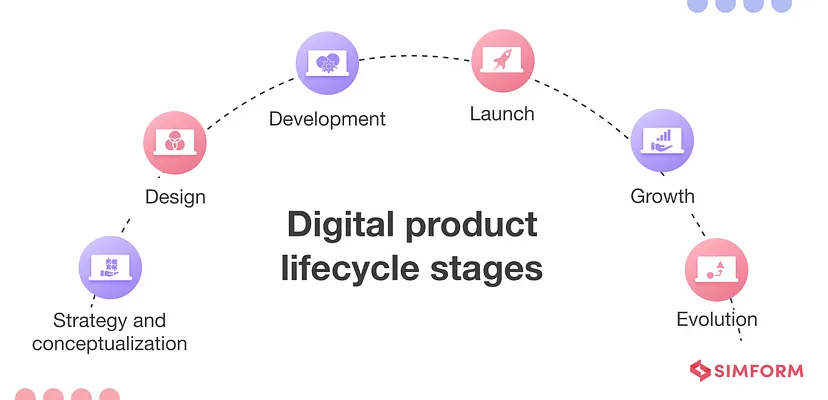Staying competitive in the fast-paced digital sector requires more than just great ideas or advanced tools. The crux lies in formulating a digital product strategy that resonates with changing trends and is adaptable to future shifts. Such an approach ensures a product aligns with user demands, retains relevance through its lifecycle, and integrates effectively into a thoughtful market-entry plan.
Here, we’ll explore how businesses can craft strategies that sync with emerging trends, foster creativity, and maintain a competitive edge.
Why Market Trends Should Drive Your Digital Product Strategy?
Market patterns provide an insightful glimpse into consumer behavior, technological advances, and industry shifts. By studying these movements, companies can ensure their offerings remain timely and meaningful. Ignoring these patterns risks delivering products that fail to meet expectations or capitalize on opportunities.
Building a thoughtful strategy involves a thorough exploration of market behaviors. This includes tracking large-scale shifts such as increased digitization, specific consumer preferences like demand for eco-friendly tech, and innovations in fields such as machine learning or virtual reality.
By anchoring your product development process to these observations, you can stay ahead of competitors with a well-defined digital product strategy.

Image Source: Medium
Core Components of an Effective Digital Product Strategy
Crafting a digital product strategy that stands out involves several core components:
1. Focus on User Needs while crafting a Digital Product Strategy
At its core, a strong product plan centers on addressing real challenges that customers face. This requires gathering feedback, conducting interviews, and observing trends to understand what audiences value most.
2. Tracking Market Signals
To maintain relevance, businesses must keep tabs on changes in the industry. This might involve keeping an eye on technological breakthroughs, watching competitors closely, or staying alert to cultural shifts that could influence buyer preferences.
3. Coordinating Product Launch Plans
A comprehensive strategy includes clear steps for getting the product to buyers. From selecting the right channels to defining marketing messages, a well-thought-out launch strategy ensures your product reaches its intended audience effectively.
4. Considering the Product’s Timeline
Every product has a natural progression—from introduction to maturity to eventual decline. A well-crafted digital product strategy accounts for these phases, preparing for updates, expansions, and potential retirement plans to maximize long-term success.
How to Adapt Your Strategy to Market Changes Effectively?
To keep a product in tune with changing trends, businesses can implement these practices:
1. Use Analytical Tools to Spot Trends
Tools like consumer surveys, web analytics, 42Signals ecommerce analytics, and industry publications can provide actionable insights into shifting preferences and future possibilities. These resources help businesses make informed decisions rather than relying on guesswork.
2. Encourage Creativity in Development in your Digital Product Strategy
Innovation is a continuous process that ensures products stay ahead of expectations. Whether by adding unique features or improving overall performance, creative improvements attract attention and keep products relevant.
3. Adjust to New Customer Expectations
As lifestyles and habits evolve, so do the desires of customers. By closely monitoring these shifts and responding with timely updates, businesses can keep their offerings in sync with user preferences.
4. Foster Collaboration Across Teams
Effective digital product strategies rely on cohesive input from marketing, development, and sales teams. Open communication ensures everyone contributes to a unified vision that reflects market realities.
What Role Does a Launch Plan Play in Digital Product Strategy Success?

Image Source: Product Plan
An effective market-entry approach complements a sound product strategy by bridging the gap between creation and adoption. Here’s how to ensure the two are aligned:
1. Craft a Message That Resonates
Marketing messages should reflect what’s currently important to buyers. Highlighting how a product addresses specific challenges or enhances daily life helps establish trust and appeal.
2. Choose the Right Distribution Methods
Different audiences favor different ways of engaging with products. Identifying where your customers spend time—whether online, in stores, or through specialized platforms—can make your approach more efficient.
3. Plan Pricing Wisely
Deciding on a price point requires balancing affordability for the customer with profitability for the company. A competitive yet reasonable pricing model can attract interest while sustaining growth.
How to Sustain Product Value Throughout Its Lifecycle?
The real test of a digital product strategy lies in its ability to remain meaningful across time. Businesses can maintain value with the following approaches:
1. Continuous Refinement
Regular updates and enhancements ensure a product stays fresh and appealing. Listening to user feedback and responding to their needs keeps the relationship between brand and customer strong.
2. Expanding Use Cases of your Digital Product Strategy
Diversifying how and where a product can be used opens new opportunities for engagement. Entering new markets or tailoring offerings to niche audiences can extend a product’s lifespan significantly.
3. Prepare for the End Phase
As demand wanes, having a plan for the product’s final stage can reduce financial losses. This might include transitioning customers to newer products or repurposing certain aspects of the original.
Netflix’s Approach to Navigating the Changing Market Landscape
Netflix serves as a clear example of a company that keeps its strategy flexible to match changing trends. Initially focused on physical DVD rentals, Netflix shifted its model to online streaming, recognizing the growing demand for on-demand content.

Image Source: App Venturez
Later, the company expanded further by creating exclusive series and films, directly addressing the diverse tastes of its audience.
Even today, the company competes with other OTT services by ensuring its user experience, movies, and show selection remain current and exclusive. The launch of newer forms of entertainment, like games and interactive movies requiring audience participation, has also made the platform unique in its services.
By maintaining a commitment to innovation and staying in tune with market movements, Netflix has solidified its place as a leading force in digital entertainment with a continuously evolving digital product strategy.
Conclusion on Digital Product Strategy
Creating a digital product strategy that reflects current trends is an ongoing endeavor that requires keen observation and thoughtful adaptation.
By focusing on user expectations, fostering originality, and aligning product plans with a well-conceived market-entry approach, businesses can ensure their products thrive in competitive markets. A forward-looking perspective—paired with readiness to adjust course—will ensure that the product not only reaches its audience but continues to serve their needs for years to come. Schedule a demo today to see how our solutions can help you align your product with market trends and drive long-term success.
Frequently Asked Questions
What is the strategy of a digital product?
The strategy of a digital product is the long-term plan that outlines how the product will solve user problems, deliver value, and achieve business goals in a competitive digital environment. It typically includes:
- Target audience definition
- Unique value proposition
- Feature roadmap and prioritization
- Revenue and monetization model
- Customer feedback and iteration loop
- Go-to-market and growth strategy
What are the 4 digital strategies?
The four core digital strategies that organizations use to grow and adapt in a digital-first world are:
Customer Experience Strategy – Creating seamless, personalized, and frictionless experiences across all digital channels.
Operational Efficiency Strategy – Using technology to automate, streamline, and improve internal processes.
Digital Innovation Strategy – Launching new digital products, services, or business models to disrupt or lead markets.
Data-Driven Strategy – Leveraging analytics and AI to inform decisions, predict trends, and personalize offerings
What are the 5 rules of digital strategy?
The 5 key rules of digital strategy serve as guiding principles for building successful digital initiatives:
Start with the customer – All strategies should begin by understanding real user needs and expectations.
Be data-informed – Let analytics and insights drive priorities, not assumptions.
Move fast and iterate – Build in short cycles, test early, and adapt quickly.
Think platform, not product – Design scalable ecosystems, not just one-off solutions.
Align with business goals – Digital initiatives must support the broader company vision and deliver measurable value.





